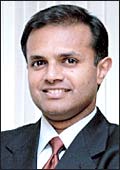| TCS: The
most multinational of Indian vendors, the company boasts the
broadest range of offerings. It also has the lowest billing
rates among the Big Three and is perceived as being conservative
in its marketing and branding efforts
INFOSYS: It
boasts the highest net profit margins, has a halo around
its head, and is a strong player in the BFSI segment that
contributes a third of its revenues, although it is largely
absent from several key verticals
|
Tata
Consultancy Services (TCS), Infosys Technologies and Wipro, three
Indian companies the world knows best, members of the exclusive
club that is Tier-I of the Indian software services business and
darlings of the stock market won't admit it, but they are, all
of them, participants in a race to touch the $10-billion-in-revenues
(Rs 45,000 crore) mark. All three should reach this mark by 2010,
maybe sooner. At stake are bragging rights and universal recognition
that the company in question has indeed arrived on the international
it firmament.
They have size on their side and in industry-lingo,
this provides traction. As Nandan Nilekani, CEO, President, and
Managing Director of Infosys, points out, it took his company
23 years to reach the $1 billion (Rs 4,500 crore) mark and another
23 months to reach $2 billion (Rs 9,000 crore). They also have
the dynamics of the global offshoring business on their side.
A report by India's software lobby NASSCOM and consulting firm
McKinsey puts the size of the offshoring business at $110 billion
(Rs 4,95,000 crore) by 2010. If India were to maintain its current
share, that would mean an industry worth $60 billion (Rs 2,70,000
crore). With some luck, that could be $75 billion (Rs 3,37,500
crore). And it is more than likely that a little over $30 billion
(Rs 1,35,000 crore) of this will come from TCS, Infosys and Wipro.
Each of the companies has something going for it: TCS, the ability
to win big, really big deals; Infosys, the very fact that the
company in its entirety is one mean (and very effective) marketing
machine; and Wipro, its innovative streak and willingness to make
as many strategic acquisitions as need be. So, who'll get there
first?
Same, Yet Different
From the outside, there isn't much separating
the three companies. As Alok Shende, Head (Infotech, Communications
and Telecom Practice) at research, analysis and consulting firm
Frost & Sullivan says, at a macro-level, "customers see
them similarly, albeit with each having strengths in certain areas".
Yet, the three companies are working towards building unique differentiators.
"Both Toyota and Honda have a similar portfolio of cars,
yet are very different companies," says James V. Abraham,
Director, Boston Consulting Group (BCG). "It's the same with
these it majors; we are seeing early signs of a differentiation
built around capabilities."
| WHO WILL GET TO $10-BILLION-IN-REVENUES FIRST? |
| What's a more
important measure of a company's ability to get to $10-billion-in-revenues
ahead of its peers? Financial performance or scalability?
Innovation or systems? This magazine found itself wrestling
with such issues, although it did have a lot of help from
experts. The scores assigned to the companies, however, are
this magazine's own and based on its understanding of them.
What do they say? That TCS will get to $10 billion ahead of
Infosy, but only just, and that Wipro will be the last to
do so. |
TCS boasts the broadest range of offerings,
and is the most multinational of Indian vendors. It also has the
lowest billing rates among the Big Three and is perceived as being
conservative with its marketing and branding efforts. Infosys
boasts the highest net profit margins, has a halo around its head,
and is a strong player in the banking, financial services and
insurance (BFSI) segment that contributes a third of its revenues,
although it is largely absent from several other key verticals
(think healthcare, life sciences, auto and government). Wipro
has significant strength in R&D, technology services and infrastructure
management, but it boasts the lowest net profit margins among
the Big Three (although this can be explained by the company's
diversified nature; software services, including it enabled services
or ITEs accounted for 8.4 per cent of its revenues in 2005-06).
Interestingly, there are no 'exclusive' verticals or service lines
with each of the three either having or planning a presence in
most.
Reinforcing this nascent differentiation
around service offerings is the fundamental DNA of the three companies.
Infosys, explains BCG's Abraham, has always emphasised on branding,
systems and processes, and culture (these, the company believes,
will result in superior quality and higher profit margins). Wipro
has an innovation-led approach, is willing to experiment and has
an appetite for risk. And TCS comes with a strong engineering
base. Even here, however, nothing is exclusive: Infosys does experiment,
Wipro does focus on systems and processes and TCS believes it
has a strong culture. Each company, believes Siddharth Pai, Partner,
TPI International, a sourcing advisory, has its own strategy.
Thus, one might entertain notions of becoming the world's best
software factory. Another could try and move up the value chain,
becoming a business transformation specialist like Accenture in
the process.
 |
 |
 |
"It will be imperative for an Indian
firm that lacks the on-ground capability of an IBM or an Accenture
to acquire in complex geographies" Partha Iyengar
Vice President (Research)/ Gartner India |
"As the Big Three move towards the
$10 billion mark, they will find themselves having to build
a presence in countries like Germany and France"
Alok Shende
Head (ICT Practice)/
Frost & Sullivan |
"The margins cannot be sustained.
Savvy M&As, particularly in domain-specific consulting and
systems integration, will be the key to profitable growth"
Dana Stiffler
Research Director (Consulting & IT Services)/AMR Research
|
The Common Challenges
For any strategy to work, however, adds Pai,
the three companies will have to focus on two areas that they
have traditionally overlooked. "The first is a global presence
that none of the three has." "The second is the willingness
to incur more risk by bringing the clients' operations and people
onto their balance sheet." This last, of course, is outsourcing
of the sort global biggies such as IBM and EDs do. There are other
challenges the three will have to address as well: scalability,
managing a multi-cultural workforce, engineering M&As and
protecting their margins. It is their high net profit margins
that give the Big Three their huge valuations, of between eight
and 10 times revenues. Infosys' market capitalisation to revenues
ratio, for instance, is 10.21, Wipro's 8.49 and TCS' 7.22. In
contrast, those of IBM, Accenture and EDs are 1.42, 1.47 and 0.7,
respectively.
That'll take some doing. Dana Stiffler, Research
Director (Consulting & it), AMR Research, an IT advisory,
is convinced that in the long run "these margins cannot be
sustained". "As these companies pursue more high-value
businesses, requiring them to pay higher salaries, it will adversely
affect margins," she adds. Then, Indian IT firms do have
to live with low-cost competitors from emerging destinations such
as China, Vietnam, the Philippines, even Pakistan.
| WIPRO: The
company has significant strength in R&D, technology services
and infrastructure management, but it has the lowest net profit
margins among the Big Three, although this can be due to its
diversified nature |
Already, claims Partha Iyengar, Vice President
(Research), Gartner India, an IT research and advisory company,
"the global firms are proving that they can compete in this
(the low-cost) space as well". Today, IBM employs around
40,000 people in India; Accenture, 18,000 and EDs, should its
Mphasis buy go through, 15,000. Indian it firms may have pioneered
the global delivery model, but the multinationals have clearly
caught on, and caught up fast. "It is only a matter of time
before they perfect it," says Sanjay Purohit, Head (Corporate
Planning), Infosys. And so, the three Indian firms are moving
beyond cost arbitrage.
Accelerating this move is the need the large
Indian it firms feel to hire locals. Today, 6.5 per cent of TCS'
workforce is composed of people of nationalities other than Indian.
The corresponding proportion for Infosys is 3.5 per cent. These
proportions will have to increase if these companies want to be
seen as global players. Doing that will also insure them against
a potential backlash against outsourcing. Infosys, for instance,
made 500 offers on Ivy League campuses this year. The flip side?
Global hires push up costs.
The Big One: Will It Happen?
TCS, Infosys and Wipro are each sitting on
close to $1 billion in cash. Then, there is their highly priced
(and prized) equity that can be used as M&A currency. For,
it is increasingly becoming clear that the three companies will
have to make acquisitions, if not in the short- or medium-term,
then eventually. "Savvy M&As, particularly in domain-specific
consulting and systems integration, will be the key to profitable
growth," says AMR's Stiffler. The lady is right: companies
can develop such skills in-house, but that will take time. The
thing about M&As is that they are so difficult to get to work.
Wipro, the most aggressive Indian firm in this context with a
string of acquisitions, has had mixed results with them, says
Frost & Sullivan's Shende. As they move towards the $10 billion
mark, the three firms will find themselves having to build a presence
in countries such as Germany and France. These are complex geographies,
says Gartner's Iyengar, and "it will be imperative for an
Indian firm that lacks the on-ground capability of an IBM or an
Accenture to acquire".
 |
 |
"Both Toyota and Honda are very different.
It is the same with these IT firms; we are seeing early signs
of differentiation built around capabilities"
James V. Abraham
Director/Boston Consulting Group |
"The firms will have
to focus on two areas. First, a global presence that none
of the three has and second, the willingness to incur more
risk"
Siddharth Pai
Partner/TPI International |
Acquisitions could also help TCS, Infosys
and Wipro address an issue that no one seems to be doing anything
about. The profile of employees within the three companies is
overwhelmingly biased towards techies. However, as most it firms
have realised, customers no longer want technology-solutions;
they want business-solutions. India may have a surfeit of techies
(at least, right now), but it doesn't boast too many domain specialists
or consultants (which is the kind of profile the Indian companies
need to hire).
Blue-sky Threats
It may sound like science fiction, but the
big threat to the offshore model popularised by TCS, Infosys and
Wipro is emerging trends in automation. Intelligent technology
infrastructure that manages itself, systems and code that maintain
themselves, and other such could render the people-heavy model
Indian companies operate on irrelevant and obsolete.
In their growth towards the $10-billion-in-revenues
mark, Indian it's Big Three will also find themselves being constrained
by the country's education system. Today, the technical and business
education system in the country is equipped to churn out armies
of doers or order-takers, not thinkers.
So, which of the three Indian firms will
get the $10 billion mark first? Size favours TCS, the market,
Infosys (the company's forward looking 12 months price-earnings
multiple for 2006-07, at 25.82, is higher than TCS' 25.6 and Wipro's
25.13), and the sheer willingness to go out and acquire a company,
Wipro. On the basis of an assessment that goes beyond these basics
(see Who Will Get To $10-billion-in-revenues First?), this magazine
has reason to believe that TCS will indeed be the first to reach
the mark. Still, this is one of those races that holds forth the
promise of a surprise or two. And it is one of those races where
the running promises to be as exciting as the finish.
-additional reporting by
Rahul Sachitanand
|








